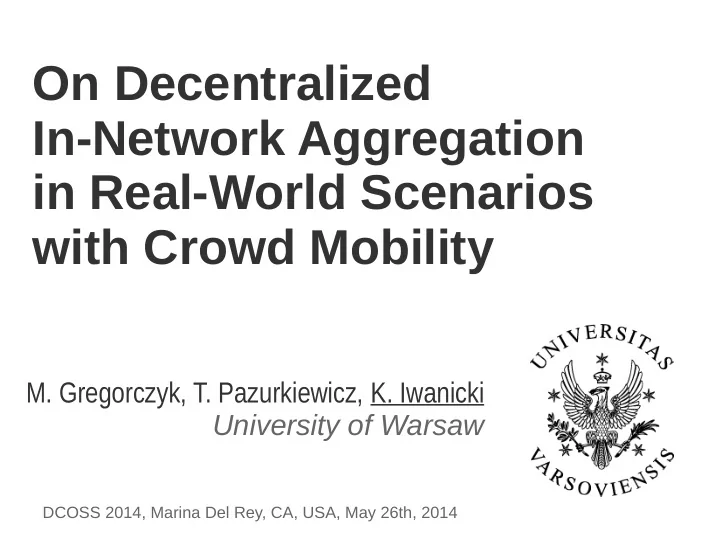

On Decentralized In-Network Aggregation in Real-World Scenarios with Crowd Mobility M. Gregorczyk, T. Pazurkiewicz, K. Iwanicki University of Warsaw DCOSS 2014, Marina Del Rey, CA, USA, May 26th, 2014
Monitoring Crowds Image source: http://en.wikipedia.org/wiki/File:Crowd_in_street.jpg ● Our interest: – utilize sensing, processing, and communication capabilities of low-power wearable devices – to monitor the behavior of crowds from the inside. ● Envisioned effect: – Deeper understanding of crowd behavior – More informed planning (e.g., transportation, infrastructure) – Ability to manage and control crowds in real time
In-Network Aggregation Problem: data deluge. ● adapted from image: http://www.clker.com/clipart-smaller-crowd-rdc.html One of the solutions: ● decentralized in-network aggregation: Each node senses its surroundings. – It communicates its observations – via low-power radios to other nearby nodes. The nodes collaboratively – aggregate the readings to reduce the traffic volume to an external monitoring site. We target basic aggregates: ● AVG, COUNT, MAX, MIN, SUM –
Aggregation in Sensornets Volumes of Aggregation Techniques
Aggregation in Sensornets Structured Aggregation Techniques Volumes of Aggregation Techniques Unstructured Aggregation Techniques
Aggregation in Sensornets Structured Aggregation Techniques Volumes of Aggregation Gradual Techniques Variance Reduction (GVAR) Unstructured Aggregation Techniques Order- and Duplicate-Insensitive Sketches (ODIS)
Gradual Variance Reduction (GVAR) ● To compute a global average: 1. Select random neighbor Each node periodically selects – v1 v2 another neighbor at random. 2. Exchange local values It exchanges its local value with – the neighbor's local value. v1 v1 v2 Both nodes set their local values – to the average of two values. v2 v1 v2 Over time, the local node values – converge to the global average. ● To count the number of nodes: 3. Average local values 3. Average local values One node sets its initial local – va va value to 1. va ← (v1+v2)/2 va ← (v1+v2)/2 Others set their values to 0. – 4. Repeat periodically
Order- & Duplicate-Insensitive Sketches (ODIS) probability of selecting bit ● To count the number of nodes: All nodes maintain local 16-bit – bitmasks (initially all zeroes). ½ ½ ½ i+1 ½ 4 ⅛ ¼ ... ... Each node sets one bit in the – i 3 2 1 0 bitmask with the index drawn from a geometric distribution. less probable more probable Repeatedly exchanges its bitmask – with its neighbors OR-ing the received bitmasks with its own. When all bitmasks have – converged, the number of nodes is 0 1 0 1 ½ 1 ... ... estimated as: i 3 2 1 0 ● 1.2928 • 2 pos0 , where pos0 is the position of the least pos0 significant 0. estimated count: 1.2928 • 2 2 = 5.17
Base Simulated Scenario Done in OMNeT++ with MiXiM extensions for wireless sensor networks. G1 = 333 nodes; G2 = 222 nodes; G3 = 444 nodes a node's aggregate = COUNT of nodes in the node's connected component.
GVAR Results
ODIS Results
Improving Communication To improve communication we adapt the Trickle algorithm for code ● propagation to ODIS aggregate computation. Normally, broadcast your bitmask randomly within every T max time – units. But, when your bitmask changes significantly shrink the interval to T min . – Each subsequent interval doubles up to T max . – Suppressing broadcasts when several similar bitmasks are received. – Effect: When the local bitmast quickly compute aggregates while minimizing traffic when the system is quiescent.
ODIS with New Communication
Improving Accuracy Use many instances of sketches: smoothing . ● Use more efficient sketches: ● parameterless sketches: – can be used out-of-the-box, but ● are not the most efficient ones (wrt. error / #bits). ● parametrized sketches: – are very efficient, but ● their accuracy depends on the final result. ● – Solution: pipelining a parameterless sketch with a parametrized one. Effect: The accuracy improves for the same number of bits.
ODIS with Improved Accuracy
Back to Real-World Experiments ● We implemented the Image source: http://electronicdesign.com/content/14978/59382_fig_01.jpg algorithms as an aggregation service for TinyOS. ● We conducted several real- world deployments of the service. – Up to 177 nodes. ● Mostly on eZ430 Chronos smart watches.
Sample Scenarios G1 = 20 nodes; G2 = 19 nodes; G3 = 15 nodes
Results (Scenario 1) G1 = 20 nodes; G2 = 19 nodes; G3 = 15 nodes
Results (Scenario 2) G1 = 20 nodes; G2 = 19 nodes; G3 = 15 nodes
Conclusions ● To be applied in real-world crowd-monitoring scenarios, decentralized in-network aggregation algorithms for sensornets require considerable adaptation. ● Applications have to be prepared that the aggregates they see may exhibit errors. ● We may need to revisit some of their assumptions. ● (Conducting real-world crowd-monitoring deployments is challenging.)
Thank You Questions? Supported by the (Polish) National Science Centre (NCN) within the SONATA programme under grant no. DEC-2012/05/D/ST6/03582.
Recommend
More recommend